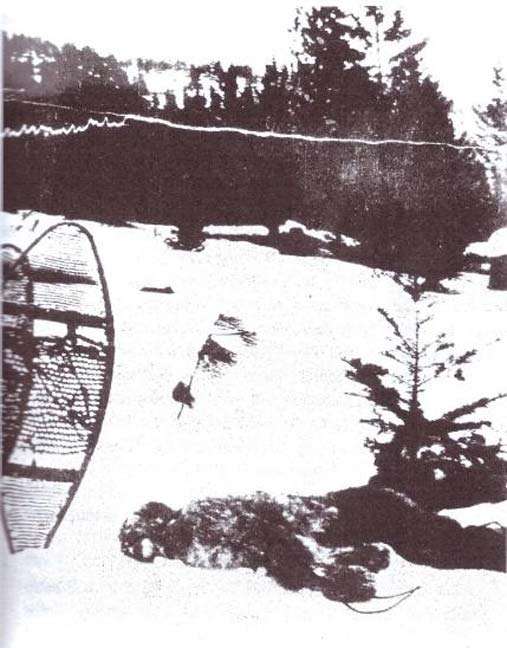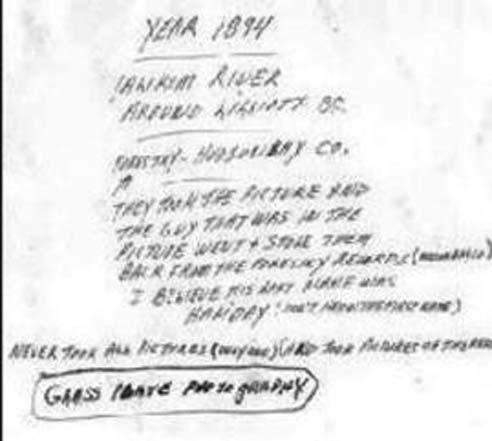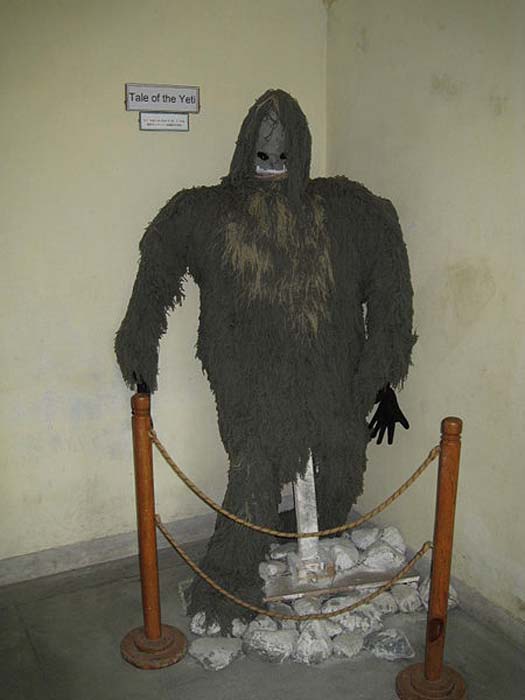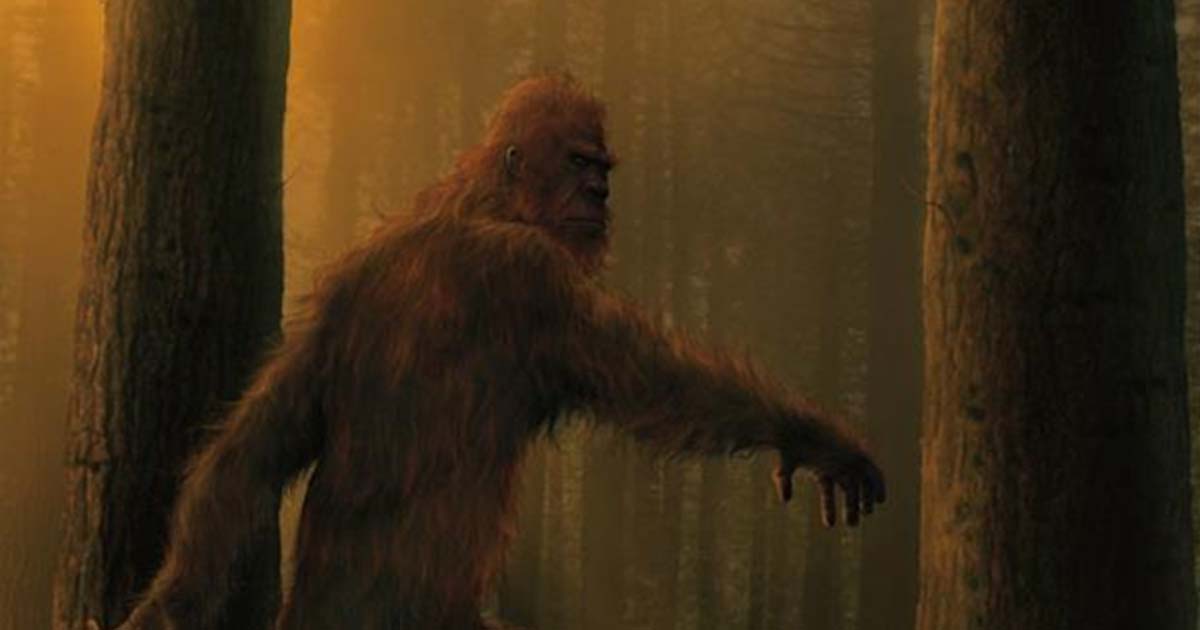The Oldest Bigfoot Photo: A Cryptozoology Conspiracy?
There is an astonishing photo from Canada taken in 1894 which would seem to be the oldest known photograph of bigfoot. The photo had originally been sent to Tom Biscardi by Lyle Billett of Victoria, Canada. Cryptomundo blogger Loren Coleman then posted the photo on his website, where I saw it. The photo also appears in the updated version of the 1982 book Bigfoot Casebook by Colin and Janet Bord.
It is said that a picture tells a thousand words, and this photo says a lot. It does not seem to be a fake. The photo is cracked from a fold in the upper quarter. A sasquatch is lying on the snow with its arms in front, so the hairy hands can be seen. The face is hairy but not very detailed. Snowshoes can be seen at the left edge of the photo. There seems to be a fence and a building on the right side, just beneath the crack. The feet of the dead sasquatch are not seen, cropped out of the right side of the photo.

The 1894 photo of bigfoot. (Author provided)
The Story Behind the Photo
The story that this photo tells us is that in 1894 in the wilds of western Canada some trappers and mountain men encountered a bigfoot and shot him. It may have happened near their cabin. They took a photograph of it. But there is more: the photo had some writing on the back of it.
- Bigfoot Is Not the Only Elusive Creature Said to Roam the Canadian Wilds
- The Maero: Bigfoot in New Zealand Folklore
The back of the photo bore this text:

There is writing on the back of the bigfoot photo. (Author provided)
Year 1894
Yalikom River Around Lilliott B.C.
Forestry-Hudsonbay Co.
They took the picture and the Guy that was in the picture went & stole them back from the forestry records (hudsonbay co.) I believe his last name was Holiday (Don’t know the first name)
Never took all pictures (only one) and took pictures of the rest.
(Glass Plate Photography)
A Coverup
This is very interesting information and confirms what some have suspected for many years: there is something of a cover-up going on concerning evidence of bigfoot. We now get a more complete story: There was more than one photo, and someone named Holiday apparently took the photos, or was pictured in one or more of them. He went to the forestry records of the Hudson’s Bay Company where he “stole back” one of the photos—the number of photos taken of the bigfoot is not known. We might guess that there were four or five original, glass plate photos.
So, some trappers shot and killed a bigfoot in 1894, and they worked for the Hudson’s Bay Company, Canada’s earliest trading company, founded in 1670. The Hudson’s Bay Company is no ordinary company; it was the de facto government in large parts of North America before European states or the United States were able to lay claim to areas in this vast domain.

Trading at a Hudson's Bay Company trading post. (Public Domain)
Owners of Rupert’s Land
Today it is one of the oldest operating companies in the world. Begun as a fur trading company on the Hudson Bay, it now has its headquarters in the Simpson Tower in Toronto. At one point the Hudson’s Bay Company had its own country of a sort, called Rupert’s Land. At that time, the Hudson’s Bay Company was one of the largest landowners of the world, with approximately 15% of the land mass of North America. Rupert’s Land consisted of lands that were in the Hudson Bay drainage system—basically the land surrounding any rivers that drained into the Hudson Bay.
It was named after the first governor of the company, Prince Rupert of the Rhine, who was a nephew of Britain’s King Charles I. The governor and the Company of Adventurers of England Trading comprised the original group that chartered the Hudson’s Bay Company.
- Wildman, Chinese Version of Bigfoot: Sightings, Scientific Tests, Theories
- Is There Archaeological Evidence of Bigfoot? (Part I)
Rupert’s Land and the Hudson’s Bay Company had their headquarters at the York Factory, a town and fort along the Hayes River leading into Hudson Bay. Once the capital of Rupert’s Land, it was closed down by the company in 1957.
The Hudson’s Bay Company nominally owned Rupert’s Land for 200 years, until about 1870, some 24 years before this photo was allegedly taken—and suppressed.

1825 illustration of Hudson's Bay Company officials in an express canoe crossing a lake. (Public Domain)
Still, the Hudson’s Bay Company was very powerful in 1894 and remains a major fixture in the Canadian economy today as the owner of many of Canada’s retail chains such as The Bay, Zellers, Fields and Home Outfitters. The company has archives, located in Winnipeg, Manitoba, said to be a collection of the company’s records and maps—does it include some bigfoot photos? That is what the writing scribbled on this bigfoot photo suggests.
Where is All the Evidence?
One has to wonder, if this photo is genuine, why it was not published many years ago, and featured in every bigfoot book written since 1894? Here we have what seems to be some pretty solid evidence of bigfoot-sasquatch that is just what the scientific community says they are looking for. In fact, these folks from the Hudson’s Bay Company not only have some photos of a dead bigfoot, but at one time (say the photos) they actually had a dead bigfoot! We are talking here about bigfoot steaks, bigfoot fur, a bigfoot head, bigfoot paws and all that.

Detail of bigfoot in the 1894 photo. (Author provided)
Since the Hudson’s Bay Company specialized in dead animals and their fur, one would think that this animal—whatever it was—was carefully skinned and preserved. Was its head mounted and displayed in the den of some chairman of the company? That seems far-fetched today, but perhaps back in 1894 it might have been seen, perhaps surrounded by some secrecy, in some Canadian or British aristocrat’s personal collection.
Because of my interest in bigfoot and other hidden animals, I’ve often been asked the question, “Why isn’t there more evidence for bigfoot than just stories? Where are the photos and where are the dead bodies that must have been found over the years?”
I have typically said in answer to these questions that one does not see a dead bear or mountain lion on the trail when walking through the Rocky Mountains or the Pacific Northwest. Though these animals are known to exist, one rarely sees them at all and never a dead one just lying there in the forest. The carcass would only be there for a few hours, days or weeks, and many animals that are about to die (of old age or disease) go off somewhere very far out of the way.
But now we have another explanation. One that is startling to the researcher and the skeptic alike—that evidence of bigfoot, including good photos and preserved bodies, has been gathered but kept a secret. “But why?” you ask. Why wouldn’t the Hudson’s Bay Company just publish its photos and display a mummified bigfoot to gawking tourists in Toronto? Why would the Canadian government (or American or British) suppress evidence of bigfoot? Don’t we live in a transparent society where everything that exists—and there are clear photos and bodies of—would be shown to the interested viewers around the world?

Sign on Pikes Peak Highway. ( CC BY SA 3.0 )
Or do we live in world where some things are suppressed, including evidence of bigfoot? Add to the suppression of real bigfoot evidence some hoax bigfoot cases that everyone can laugh at, and you have a subject that appears to be just fantasy and tall tales. Some things are just too shocking to the status quo—strange mutations or missing links that make us question traditional religious beliefs or the tenets of mankind’s sacred pillars of science and reason. If all the experts and scholars have been so wrong for decades, what are we supposed to believe from them?
In the case of this photo, part of a series apparently, a professional photographer must have been involved. Photography, until recently, was expensive and rare; it required professional photographers with expensive, heavy equipment. Having a photograph taken in 1894 was a big deal, glass plate photography being very time consuming for each individual photo. Taking such photos in the wilderness would have been quite an endeavor. Photography for the common man took many decades to reach even the Kodak Brownie and Instamatic periods of the 1940s and 1960s. Then, finally, common folk could have a simple camera with them to take photos when they were on long camping trips and hikes in remote mountain areas.

A composite photograph from 1893 showing a photographic studio interior. One man is seated on a stool near an adjustable clamp to hold his head steady during a long portrait exposure. The second man, standing next to a large view camera, looks like the person being photographed. (Public Domain)
Looking for Lilliott
Also, what of this location in British Columbia? I found that if I searched the internet for the Yalikom River, as written on the back of the photo, what I found was the Yalakom River which is a tributary to the Bridge River which is a principal tributary to the Fraser River, a major part of Rupert’s Land territory. Plus, I was able to find out that the Yalakom River enters the Bridge River near the town of Lillooet, which is apparently the town mentioned as Lilliott.
Lillooet is apparently one of the oldest towns in North America. It is so old that its age is not known. It is considered to be one of the oldest continuously inhabited locations in North America, reckoned by archaeologists to have been inhabited for several thousand years. The town attracted large seasonal and permanent populations of native peoples because of the confluence of several main streams with the Fraser, and also because of a rock-shelf just above the confluence of the Bridge River that is an obstacle to the annual migration of salmon—an abundant food source.

Fraser River in Lillooet. (Andybremner2012/CC BY SA 4.0)
Did this salmon-shelf cause the downfall of our unfortunate sasquatch, shot by a trapper in the employ of the Hudson’s Bay Company? According to the information on Lillooet this natural shelf along the riverbed is an important salmon station on the Fraser-Bridge-Yalakom River:
This rock shelf, known in gold rush times as the Lower Fountain, was reputedly made by the trickster Coyote, leaping back and forth across the river to create platforms for people to catch and dry fish on. This location, named Sat’ or Setl in the native language and known as the Bridge River Rapids or Six Mile in English, is the busiest fishing site on the Fraser above its mouth and there are numerous drying racks scattered around the banks of the river canyon around it.
- The Australian Yowie: Mysterious Legends of a Tribe of Hairy People
- Am Fear Liath Mor: The Terrifying Grey Man of the Cairngorms
Apeman Tourism
We now have the final scene of the tragic bigfoot in our photograph: he had come to Lillooet (Lilliott as spelled on the backside of the photo) to get some salmon which was known to be plentiful at this spot. While Native Americans who had lived in the area for thousands of years knew not to bother the sasquatch that came to this area of plenty, this poor beast was shot and killed by the Europeans now penetrating the area for the Hudson’s Bay Company. What they found shocked them. They shot and killed it. Then they took a photograph of it. Then someone in the company ordered the photo suppressed.
Yes, it seems that a cryptozoology conspiracy exists. Evidence, including photos and bodies, is kept from the press and public at large. It would seem that government and corporate identities are actively covering up evidence of bigfoot. While the governments of Canada and the United States could be trying to protect bigfoot by suppressing evidence of their existence, some countries use the apeman to promote tourism. Countries like Nepal and Bhutan promote “yeti tourism,” but still protect the species with national laws.

A representation of a Yeti at the International Mountain Museum, Pokhara, Nepal. (MMuzammils/CC BY SA 3.0)
It seems incredible, but the reality of the sasquatch—the apemen that live on the fringes of civilization—seems hard to deny when faced with what seems to be an overwhelming amount of evidence. Could all of the stories that have come down to us for nearly 200 years in North America be cases of misidentification of bears, or the occasional escaped circus gorilla? Or hoaxes? That, to me, would be very difficult to swallow.
Top Image: Artistic representation of bigfoot. (deriv) Source: wallace/Deviant Art
This article is an extract from the book: Bigfoot Nation by David Hatcher Childress, available via the following link:
https://www.adventuresunlimitedpress.com/proddetail.php?prod=BGN


















Comments
I agree with your analysis. It’s a small black bear. The snout and paws are pretty obvious in the blow up crop.
I have reviewed the 1894 photo of alleged bigfoot. The black furred creature is small when comaperd to the size of the snowshoes. It also has large claws of a black bear. The bear may be decaying, or was very sick and emaciated when alive. Pretty sure it is decaying black bear. Sorry, not a Sasquatch (as this is from BC Canada allegedly would be sasquatch, not bigfoot). Gary O.
Hello Childress,
Does anyone have an estimation of how tall these Big Foot Are? 8 feet? 10 Ft, in Ht, perhaps 16 feet? I was just curious.
1894? Anyone consider that Big Foot may carry diesases, that have been major Epidemics that nearly wiped out whole communities?
Granted the Sovereign Nations did live alongside of the Big Foot for hundreds and hundreds of years they may have been immune to them.
Diseases didn't come to the New World till Europe, brought them here such as Chicken Pox, Measles, Mumps, Smallpox, Syphilis, an Typhoid none of these diseases were here before Europe arrived in The New World.
Anyway I was just wondering.
The only diseases; that I think, we're already here in The New World, are possibly Malaria, Diphtheria, and Yellow Fever (The Great Yellow Fever of 1793, in Philadelphia). From the insect world out on The Plains of The New World Locust what a treat.
And they're people, not animals. I know this for a fact, as I had a close encounter with both the Sasquatch an a UFO on the same night in Sept. 2017.
tamifabulous
I think it’s to make the creature more difficult to identify and therefore discredit the picture
Pages